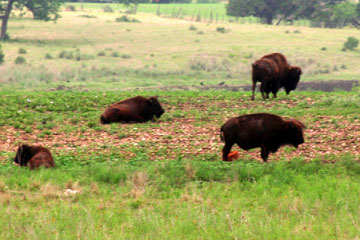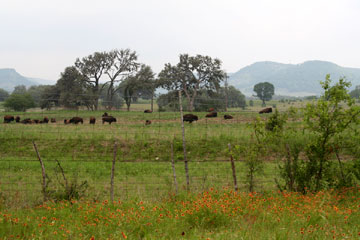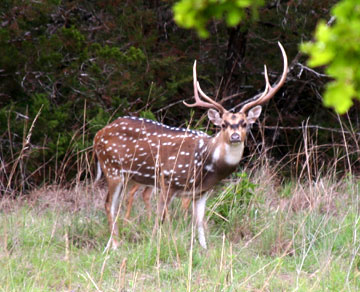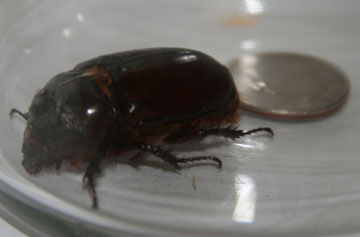 One of the things I’m enjoying about Texas is the wildlife. My family and I live in the Hill Country outside of San Antonio, a relatively rural spot with lots of wildlife, both native to the area and exotic. (Did you know the word exotic comes from the Greek word exotikos, which means “from the outside” or “from elsewhere”?)
One of the things I’m enjoying about Texas is the wildlife. My family and I live in the Hill Country outside of San Antonio, a relatively rural spot with lots of wildlife, both native to the area and exotic. (Did you know the word exotic comes from the Greek word exotikos, which means “from the outside” or “from elsewhere”?)
This part of Texas once had native buffalo. In fact, I used to live on “Cibolo Basin” street in Boerne. Cibolo is a Spanish word for buffalo, and is common in the Hill Country, reflecting the fact that buffalo were once found here naturally, and that many who found them spoke Spanish. When settlers came to the Hill Country, however, they soon decimate the native buffalo population. In recent years, ranchers have begun to raise buffalo, partly because the meat is high in protein and low in fat. I’ve had a buffalo burger (in West Yellowstone, Montana), and it was quite tasty.
 In the foreground of the photo to the right, you can see some wildflowers growing alongside the fence. I have been amazed by the number and variety of Texas wildflowers. Quite a delight! In the background you can see the larger herd of buffalo on this ranch outside of Medina, Texas. You can also see that it’s a hazy day, rather cloudy and, therefore, not yet very hot. I’ve been enjoying how much the weather in Texas changes. Yes, it can get pretty hot here, but the variety of weather is impressive, nevertheless.
In the foreground of the photo to the right, you can see some wildflowers growing alongside the fence. I have been amazed by the number and variety of Texas wildflowers. Quite a delight! In the background you can see the larger herd of buffalo on this ranch outside of Medina, Texas. You can also see that it’s a hazy day, rather cloudy and, therefore, not yet very hot. I’ve been enjoying how much the weather in Texas changes. Yes, it can get pretty hot here, but the variety of weather is impressive, nevertheless.
 A few days ago at Laity Lodge I had a personal encounter with an Axis deer buck. Axis deer are native to India and Nepal, but are “the most abundant exotic ungulate in Texas” according to The Mammals of Texas – Online Edition. (Ungulate comes from the Latin word ungula, which means claw or hoof.) Indeed, Axis deer cover the Hill Country, along with the native White-Tailed Deer. You can identify an Axis deer by its telltale spots. (Photo: This is the Axis deer that was having breakfast about fifty feet from my back door at Laity Lodge. If you look carefully, you can see that another deer was right behind the buck. That explains the multiple legs.)
A few days ago at Laity Lodge I had a personal encounter with an Axis deer buck. Axis deer are native to India and Nepal, but are “the most abundant exotic ungulate in Texas” according to The Mammals of Texas – Online Edition. (Ungulate comes from the Latin word ungula, which means claw or hoof.) Indeed, Axis deer cover the Hill Country, along with the native White-Tailed Deer. You can identify an Axis deer by its telltale spots. (Photo: This is the Axis deer that was having breakfast about fifty feet from my back door at Laity Lodge. If you look carefully, you can see that another deer was right behind the buck. That explains the multiple legs.)
 Finally, the other night I was working in my workshop with my daughter Kara. All of a sudden we heard a loud noise, as if someone had thrown a rock at the side of the building. Looking up in alarm, we saw a gigantic beetle struggling on the ground. It had obviously flown into the side of the building, which explained the loud noise we had just heard. I had never seen such a large beetle before. Doing some online research, I discovered that it was a Rhinoceros Beetle. I learned that my visitor was a female, because the males have horns on their heads, which explains the name Rhinoceros. Near as I can tell, these beetles aren’t dangerous to human. But I sure don’t want one crawling up my leg! (Photo: Another Rhino Beetle I captured a couple of nights ago. You can see how its size compares to a quarter. The first beetle I saw as a good bit larger than this “tiny” one.)
Finally, the other night I was working in my workshop with my daughter Kara. All of a sudden we heard a loud noise, as if someone had thrown a rock at the side of the building. Looking up in alarm, we saw a gigantic beetle struggling on the ground. It had obviously flown into the side of the building, which explained the loud noise we had just heard. I had never seen such a large beetle before. Doing some online research, I discovered that it was a Rhinoceros Beetle. I learned that my visitor was a female, because the males have horns on their heads, which explains the name Rhinoceros. Near as I can tell, these beetles aren’t dangerous to human. But I sure don’t want one crawling up my leg! (Photo: Another Rhino Beetle I captured a couple of nights ago. You can see how its size compares to a quarter. The first beetle I saw as a good bit larger than this “tiny” one.)
More from Beliefnet and our partners

